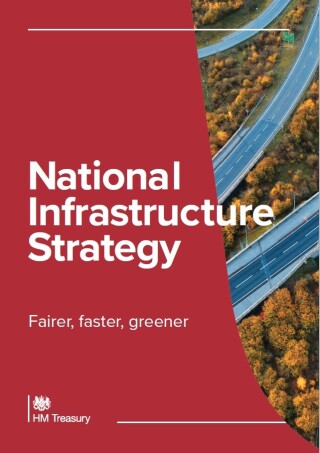This 100-page document, subtitled Fairer, faster, greener, sets out government policy on infrastructure and construction, including broadband, energy and transport, and on the carbon reduction aspirations summarised in the prime minister’s 10-point plan that he announced last week.
The National Infrastructure Strategy is based around three central objectives: economic recovery; levelling up and strengthening the Union; and meeting the UK’s net zero emissions target by 2050.
Publication of the National Infrastructure Strategy is accompanied by release of the Treasury’s 48-page Response to the National Infrastructure Assessment.
The Assessment was published by the independent National Infrastructure Commission (NIC) in October 2018 – more than two years ago.
The Treasury’s response supports, either fully or broadly, most of the NIC’s 2018 recommendations, although differs occasionally on how best to achieve agreed aims.
For example, the NIC said that the government should set a target for the rate of installations of energy efficiency measures in the building stock of 21,000 measures a week by 2020.

The Treasury’s response says that the government does not agree with the recommendation to set a measure-based target. “This is because such a target could lead to a focus on the number of measures delivered, at the expense of the energy or emissions reductions achieved. Particularly in larger commercial and industrial buildings, where it makes most sense, the government is planning to consult on moving to measuring and rewarding actual energy and carbon reductions along the lines of the successful NABERS scheme in Australia. A measure-based target could also stifle potential innovation.”
Within the National Infrastructure Strategy document, which reads much like a manifesto, there is much emphasis on getting shovel-ready projects out of the ground. There is little in terms of major policy announcement – no commitment to any more nuclear power stations, for example.
“Alongside ongoing major projects such as HS2, in the immediate-term new investment will be targeted at smaller local schemes to upgrade existing infrastructure,” it says. “These projects can be taken through planning and development quickly to provide employment opportunities in the UK construction sector that would otherwise be affected by Covid-19 and decreasing private sector demand.”
It says: “HM Treasury is strongly encouraging all government departments and their agencies to progress approved and funded projects into procurement and contract without delay (subject to good project discipline). This includes continuing to publish a comprehensive National Infrastructure and Construction Pipeline, with the next update in spring 2021.
“The government is also urging local authorities to take steps to preserve construction jobs in their areas by progressing funded projects as soon as practicable. Finally, the government will use its weight as a major construction client to transform and modernise the industry, through the publication and implementation of the Construction Playbook.”
Got a story? Email news@theconstructionindex.co.uk



